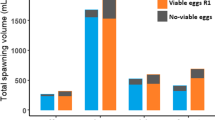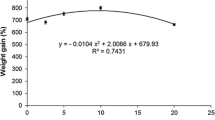Abstract.
Pleurotus cornucopiae 608 was grown on a mixture of pasteurized cottonseed hulls (75% dry wt), 24% chopped wheat straw, and 1% ground limestone. The substrate was spawned at various levels (1.25%, 2.5%, 3.75%, or 5% wet wt) and not supplemented or supplemented with commercial delayed release nutrient (Campbell's S-41) at various levels (0%, 3%, 6%, 9%, or 12%). Maximum yield (weight of fresh mushrooms harvested at maturity) was obtained at 3.75–5% spawn level and 6% S-41 supplement. As supplement levels exceeded 6%, yields declined significantly. There was a negative correlation (r=–0.81) between spawn rate and days to production. As the spawn rate increased, the number of days to production decreased. By using a spawn rate of 3.75% of the wet substrate wt, it was possible to reduce the time to production by a mean of 9.2 days compared with a spawn rate of 1.25%.
Similar content being viewed by others
Author information
Authors and Affiliations
Additional information
Electronic Publication
Rights and permissions
About this article
Cite this article
Royse, .D. Influence of spawn rate and commercial delayed release nutrient levels on Pleurotus cornucopiae (oyster mushroom) yield, size, and time to production. Appl Microbiol Biotechnol 58, 527–531 (2002). https://doi.org/10.1007/s00253-001-0915-2
Received:
Revised:
Accepted:
Issue Date:
DOI: https://doi.org/10.1007/s00253-001-0915-2




